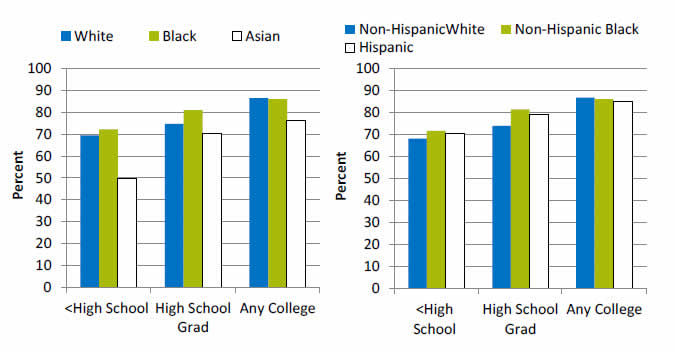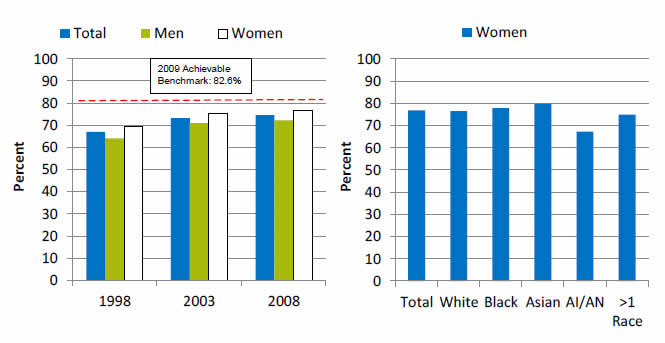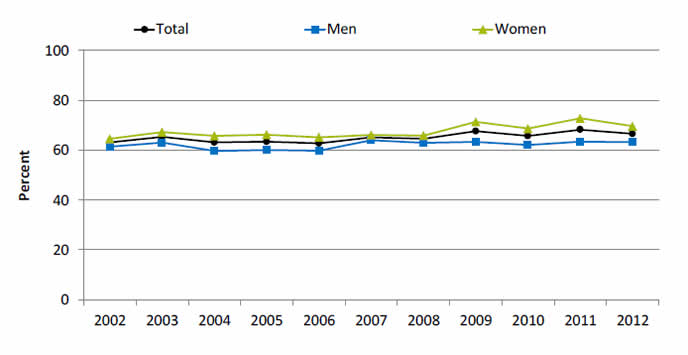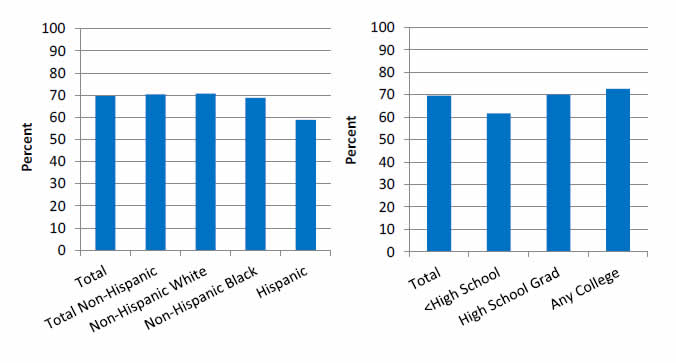Pap Smears
Women ages 21-65 who received a Pap smear in the last 3 years, by race and ethnicity, stratified by education, 2013

Left Chart (Race):
| Education | White | Black | Asian |
|---|---|---|---|
| <High School | 69.5 | 72.2 | 49.8 |
| High School Grad | 74.7 | 81 | 70.1 |
| Any College | 86.5 | 86.1 | 76.3 |
Right Chart (Ethnicity):
| Education | Non-Hispanic White | Non-Hispanic Black | Hispanic |
|---|---|---|---|
| <High School | 68.1 | 71.7 | 70.6 |
| High School Grad | 74.0 | 81.4 | 79.0 |
| Any College | 86.8 | 86.1 | 85.0 |
Source: Agency for Healthcare Research and Quality, Medical Expenditure Panel Survey, 2013.
- Importance:
- Screening aims to identify high-grade precancerous cervical lesions to prevent development of cervical cancer and early-stage asymptomatic invasive cervical cancer. Early-stage cervical cancer may be treated with surgery (hysterectomy) or chemoradiation. The treatment of precancerous rather than early-stage cancerous lesions is unique to cervical cancer and is the foundation of the success of cervical cancer screening. Treatment of precancerous lesions is less invasive than treatment of cancer and results in fewer adverse effects (U.S. Preventive Services Task Force).
- Another important way for women to receive recommended cervical cancer screening is through federally supported community health centers (CHCs), which provide comprehensive primary care services, regardless of ability to pay, helping reduce disparities and improve access of vulnerable populations. Even though CHCs tend to serve low-income and mostly uninsured or publicly insured populations, the rates of recommended screenings among women seen at CHCs are similar to the national averages of all women. In 2009, 85.2% of female CHC patients reported receiving the recommended cervical cancer screening compared with 81.2% of all U.S women (Women’s Health USA, 2013).
- Overall Rate: In 2013, the percentage of women ages 21-65 who received a Pap smear in the last 3 years was 80.7% (data not shown).
- Groups With Disparities:
- In 2013, Asian women were less likely than White women to receive a Pap smear in the last 3 years regardless of educational level. About half of Asian women with less than a high school education (49.8%) received a Pap smear compared with 69.5% of White women. For those with any college, the percentages were 76.3% for Asian women and 86.5% for White women.
- Black women with a high school education and less than a high school education were more likely than White women to receive a Pap smear in the last 3 years.
- In 2013, Hispanic and non-Hispanic Black women with a high school education and less than a high school education were more likely than non-Hispanic White women to receive a Pap smear in the last 3 years. Among high school graduates, the percentages were 81.4% among non-Hispanic Black women and 74% among non-Hispanic White women.
Blood Cholesterol Measurement
Adults who received a blood cholesterol measurement in the last 5 years, by sex, 1998, 2003, and 2008, and by race, 2008

Left Chart:
| Sex | 1998 | 2003 | 2008 |
|---|---|---|---|
| Total | 67 | 73.2 | 74.6 |
| Men | 64.2 | 71.0 | 72.2 |
| Women | 69.7 | 75.3 | 76.9 |
2009 Achievable Benchmark: 82.6%.
Right Chart (Women by Race/Ethnicity):
- Total - 76.9%.
- White - 76.5%.
- Black - 77.9%.
- Asian - 80.0%.
- AI/AN - 67.3%.
- More than 1 Race - 75.0%.
Source: Centers for Disease Control and Prevention, National Center for Health Statistics, National Health Interview Survey, 1998, 2003, and 2008.
- Importance: Early detection and treatment of high blood cholesterol can prevent heart disease and stroke. Because high cholesterol levels typically cause no symptoms, screening is essential.
- Overall Rate: In 2008, the total percentage of adults who received a blood cholesterol measurement in the last 5 years was 74.6%. In 2008, the total percentage of women who received a blood cholesterol measurement in the last 5 years was 76.9%.
- Groups With Disparities:
- In all years, women were more likely to receive a blood cholesterol measurement compared with men.
- In 2008, there were no statistically significant differences by race among women who received a blood cholesterol measurement: Whites (76.5%), Blacks (77.9%), Asians (80%), AI/ANs (67.3%), and more than 1 race (75%).
- Achievable Benchmark:
- The 2009 top 5 State achievable benchmark was 82.6%. The top 5 States that contributed to the achievable benchmark are District of Columbia, Maryland, Massachusetts, New York, and Rhode Island.
- At the current rate of change, the total population could achieve the benchmark in 11 years, men in 13 years, and women in 8 years.
Advice To Quit Smoking
Adult current smokers with a checkup in the last 12 months who received advice to quit smoking, by sex, 2002-2012

| Sex | 2002 | 2003 | 2004 | 2005 | 2006 | 2007 | 2008 | 2009 | 2010 | 2011 | 2012 |
|---|---|---|---|---|---|---|---|---|---|---|---|
| Total | 63.1 | 65.3 | 63.1 | 63.4 | 62.7 | 65.1 | 64.5 | 67.6 | 65.7 | 68.2 | 66.5 |
| Men | 61.4 | 63.0 | 59.7 | 60.0 | 59.7 | 64.0 | 62.9 | 63.3 | 62.0 | 63.4 | 63.2 |
| Women | 64.5 | 67.2 | 65.7 | 66.2 | 65.1 | 66.1 | 65.8 | 71.3 | 68.6 | 72.8 | 69.6 |
Source: Agency for Healthcare Research and Quality, Medical Expenditure Panel Survey, 2002-2012.
- Importance: Smoking is a modifiable risk factor, and health care providers can help encourage patients to change their behavior and quit smoking. The 2008 update of the Public Health Service Clinical Practice Guideline Treating Tobacco Use and Dependence concludes that counseling and medication are both effective tools alone, but the combination of the two methods is more effective in increasing smoking cessation. For more information: http://www.ahrq.gov/professionals/clinicians-providers/guidelines-recommendations/tobacco/index.html.
- Overall Rate: In 2012, the percentage of adult current smokers with a checkup in the last 12 months who received advice to quit smoking was 66.5%.
- Trends: From 2002 to 2012, the percentage of adult current smokers with a checkup in the last 12 months who received advice to quit smoking improved overall (from 63.1% to 66.5%) and for women (from 64.5% to 69.6%).
- Groups With Disparities:
- In 7 of 11 years, female adult current smokers with a checkup were more likely to receive advice to quit smoking compared with male adult current smokers.
- In 2012, female adult current smokers (69.6%) with a checkup were more likely to receive advice to quit smoking compared with male adult current smokers (63.2%).
Advice for Women To Quit Smoking
Female adult current smokers with a checkup in the last 12 months who received advice to quit smoking, by race/ethnicity and education, 2012

Left Chart (Race/Ethnicity):
- Total - 69.6%.
- Total Non-Hispanic - 70.4%.
- Non-Hispanic White - 70.7%.
- Non-Hispanic Black - 68.8%
- Hispanic - 58.9 %.
Right Chart (Education):
- Total - 69.6%.
- Less than High School - 61.7%.
- High School Grad - 70.0%.
- Any College - 72.6%.
Source: Agency for Healthcare Research and Quality, Medical Expenditure Panel Survey, 2012.
- Overall Rate: In 2012, the percentage of female adult current smokers with a checkup in the last 12 months who received advice to quit smoking was 69.6%.
- Groups With Disparities:
- In 2012, Hispanic female adult current smokers (58.9%) with a checkup were less likely to receive advice to quit smoking compared with non-Hispanic White female adult current smokers (70.7%).
- In 2012, female adult current smokers with a checkup with less than a high school education (61.7%) were less likely to receive advice to quit smoking compared with those with any college (72.6%).



